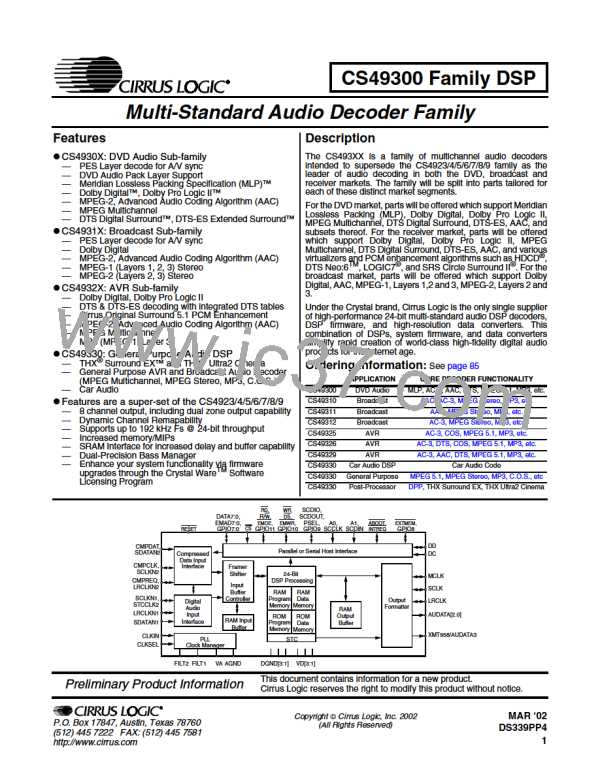CS49300 Family DSP
8.3.1. Design Considerations when using
GFABT Codes
8.5. Application Failure Boot Message
Each piece of application code is specifically
tailored for an individual part in the CS493XX
family. Although it is possible to load a piece of
code into the wrong chip and receive a
BOOT_SUCCESS byte, the code will not initialize
itself. In order to facilitate the debug of designs
which can accept many members of the CS493XX
family, an APPLICATION_FAILURE message is
provided.
The designer should be aware that the gfabt codes
do not lock the PLL, so therefore the actual time in-
volved with autobooting is subject to the open loop
VCO frequency. The PLL is only locked when the
command is sent from the host, typically along
with the kickstart command. Also, the designer
should take into account the access time of the
Flash Memory, EPROM, and latches used in their
specific design. While there is a temptation to use
the gfabt4 code which would theoretically mini-
mize the Autoboot time, the designer should realize
that this may result in the DSP to attempting to Au-
toboot too quickly, resulting in clocking times that
exceed that of the specified access times of partic-
ular external memory devices or the associated
latches.
As mentioned earlier, the host must wait for at least
5ms after download before sending configuration
messages to the CS493XX. This provides time for
the code to initialize itself. If the INTREQ pin is
low after the download process has completed, the
host should read from the CS493XX. The byte
0xF0 indicates APPLICATION_FAILURE. This
byte informs the host that the application code was
loaded into an incompatible DSP.
The designer should note that the times listed in
Table 11 were taken from 3 sample CS493264-CL
Rev. G devices and are in no way a guarantee of the
times that your design will achieve as all values are
dependent on the open loop frequency of the DSP.
Furthermore the times listed in Table 11 DO NOT
include the code initialization time (the time spent
after download while the code prepares for
messages). Therefore, the times listed above should
be used as the upper bound on boot time when
using the gfabt codes.
Although most of the messages listed in Tables 9
and 10 are essentially ignored for autoboot, it
should
be
noted
that
the
APPLICATION_FAILURE message is applicable
whether host boot or autoboot is used.
8.6. Resetting the CS493XX
Resetting the CS493XX uses a combination of
software and hardware. To reset the device, a
previous application must have been downloaded.
The flow diagram in Figure 39, "Performing a
Reset" on page 62 shows the procedure for
performing a reset.
8.4. Internal Boot
Certain applications are stored in the ROM of the
CS493253, CS493254, CS493263 and CS493264.
To enable these applications a special loader called
an internal boot assist program must be used. This
internal boot assist (or IBA) code can be
downloaded using either host boot or autoboot
methods. After the IBA program has been
downloaded, it enables the internally stored
application code. The IBA codes are typically
around 350 bytes in size and hence can easily be
stored in a host controller.
The following is a detailed description of a reset
sequence to the CS493XX. All writes and reads
with the CS493XX should follow the protocol
given in Section 6, “Control” on page 32.
1) Reset begins when the host issues a hard reset
and holds the mode pins appropriately (WR,
RD, and PSEL) as described in Section 6,
“Control” on page 32. It is assumed that the
communication protocol is followed for
DS339PP4
61

 CIRRUS [ CIRRUS LOGIC ]
CIRRUS [ CIRRUS LOGIC ]